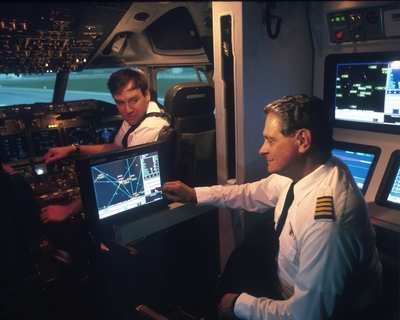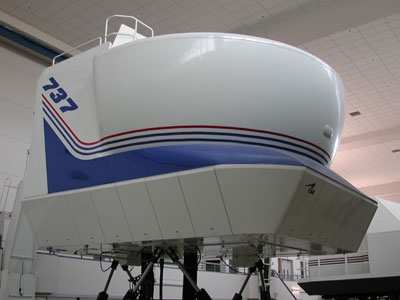Critics Warn Safety Could Be Comprised In Rush To Fill Pilot
Shortage
 A new pilot training
program that relies very heavily on simulator training is being
hailed as an answer to the ever-growing pilot shortage faced by the
international industry. The program was developed in 2000 by the UN
agency in charge of civil air traffic, the International Civil
Aviation Organization in Montreal.
A new pilot training
program that relies very heavily on simulator training is being
hailed as an answer to the ever-growing pilot shortage faced by the
international industry. The program was developed in 2000 by the UN
agency in charge of civil air traffic, the International Civil
Aviation Organization in Montreal.
The new program, named the Multi-Crew Pilot's
License, cuts ground school time and solo flying time
by making greater use of sims, according to the Associated Press.
It only requires 64 hours of actual flight time as PIC, and allows
a student to qualify as a co-pilot in 45 weeks, roughly the time
required to obtain an ordinary driver's license in Europe.
Experts, not surprisingly, warn this may not be such a good
idea.
Critics say it is merely a quick-fix scheme to cover pilot
shortages and will compromise safety. Supporters argue it improves
the ability of new co-pilots to integrate into flight crew member
positions, instead of spending long hours flying solo.
"The whole idea of MPL is to have a modern training concept
tailored to meet today's requirements, because the role of pilot
has changed from a stick-and-rudder-pusher to a manager of highly
technologically advanced systems," said Capt. Chris Schroeder of
the International Air Transport Association.
"We had to move away from the old training scheme where the
emphasis was on flying skills without any system management
whatsoever. Instead, we now have fully integrated competency-based
training for cockpit managers in aircraft such as the Boeing 787
Dreamliner."
The first six participants in the program are from China Eastern
Airlines and Xiamen Airlines. They are due to graduate later this
year.
Critics contend such sweeping changes are made from an economic
standpoint, rather than a quality one.

"Simulators are good to teach system operations, but real flying
is needed to learn airmanship, the very basis of safety," said
Philip von Schoppenthau, secretary-general of the Brussels-based
European Cockpit Association. "We're not fundamentally against the
MPL idea, but let's not reduce flying hours drastically so that the
knowledge base of airline pilots can be maintained."
According to estimates by Alteon, the Boeing Co.'s training
subsidiary, carriers worldwide are going to need 17,000 new pilots
a year until 2024 just to keep up with new aircraft deliveries.
Primary demand for pilots will be from China, India, the Persian
Gulf and Southeast Asia.
Most European aviation regulatory agencies and the Federal
Aviation Administration haven't exactly warmed to the idea of the
MPL program. Pressure is reportedly building for its use, though,
and its speculated the program will eventually be used by
established flight schools.
Those for and against agree on one issue, though. The program
and its outcomes must be fully and carefully watched and
studied.
"By itself the MPL is neither good nor bad," said Jean Benoit
Toulouse, an Air France pilot who is creating a French MPL program.
"We obviously had to modernize training because simulation devices
are now so sophisticated that they can be used in most of it. But
the MPL can also end up as a dangerous thing - like giving a
license to a co-pilot who is not up to scratch - unless national
regulatory agencies maintain strict oversight of the program."

The first test course is being conducted in Brisbane, Australia.
Alteon selected Airline Academy Australia to deliver the core and
basic phase of training using Diamond DA-40 aircraft and a DA-40
Level 5 Flight Training Device equipped with a Rockwell Collins
EP-10 daylight visual system.
 ANN's Daily Aero-Linx (05.06.25)
ANN's Daily Aero-Linx (05.06.25) ANN's Daily Aero-Term (05.06.25): Ultrahigh Frequency (UHF)
ANN's Daily Aero-Term (05.06.25): Ultrahigh Frequency (UHF) ANN FAQ: Q&A 101
ANN FAQ: Q&A 101 Classic Aero-TV: Virtual Reality Painting--PPG Leverages Technology for Training
Classic Aero-TV: Virtual Reality Painting--PPG Leverages Technology for Training Airborne 05.02.25: Joby Crewed Milestone, Diamond Club, Canadian Pilot Insurance
Airborne 05.02.25: Joby Crewed Milestone, Diamond Club, Canadian Pilot Insurance





